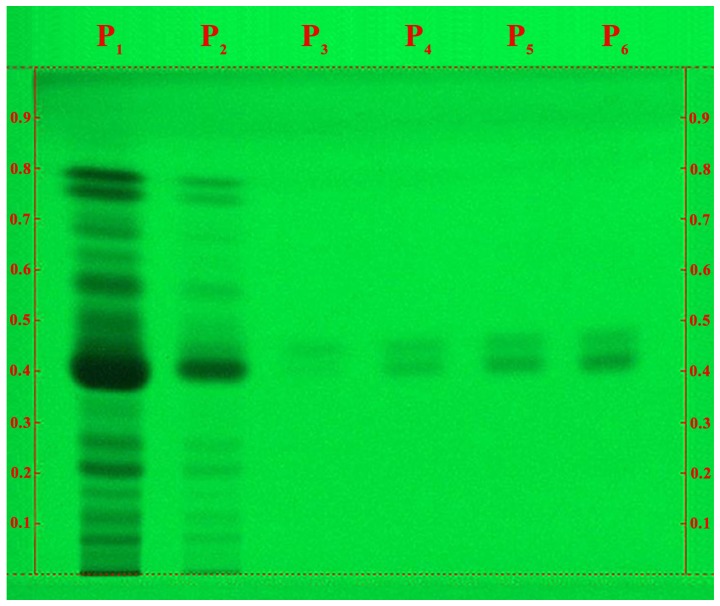Abstract
Although vitiligo is one of the most frequently occurring depigmentary disorder, its pathophysiology is still not fully clarified, resulting in the incapacity to find a targeted cure. Most of the treatment options available at the time have an anti-inflammatory or immunosuppressive effect, influencing the immune factor in vitiligo but without having a direct effect on melanocyte differentiation, migration or proliferation. This study shows that Piper nigrum (PN) extract and its main alkaloid, piperine, promote melanocyte proliferation in vivo, being consistent with previous study. A PN fruit extract and pure piperine were integrated in two different ointments and tested on human subjects affected by vitiligo. A number of 9 areas were treated: 3 using the extract, 3 using pure piperine, 1 using travoprost solution, and 2 using an association of travoprost (prostaglandin F2α analogue) solution and our products. Pigmentation was achieved in all the treated areas. The extract caused faster and more remarkable results than the pure piperine. The association of the travoprost solution speed up the process and changed the pigmentation pattern, especially when associated with the PN extract. Our early studies suggest that PN extract may represent, in the future, a new treatment option for vitiligo, especially considering the mild side effects of the tested products and the reduced amount of time needed for repigmentation. However, more studies are needed to validate this experimental data.
Keywords: Piper nigrum, piperine, HPTLC, antioxidant activity
Introduction
Vitiligo is a skin disorder that causes the skin to lose its natural pigmentation (1). It can develop at any age and there is no difference in prevalence according to sex, skin type or race (2). The affected skin can lighten or turn completely white. Some people develop a few patches while others lose much more skin color. Usually there are no other signs or local symptoms. Vitiligo can also affect other parts of the body such us the hair, the eyes, the inside of the mouth or lips. Some people develop low self-esteem, social anxiety or serious depression (1,3,4).
Usually vitiligo represents a standalone phenomenon but it can arise associated with other autoimmune conditions like thyroiditis, alopecia areata or lupus (5).
Two types of vitiligo are recognized: non-segmental (most common) and segmental. Non-segmental vitiligo is characterized by the development of depigmentation areas on both sides of the body, while segmental vitiligo is usually limited to one side of the body with typical distribution patterns in the face and trunk, which are useful for the differential diagnosis (6–9).
The therapeutic options in vitiligo include: topical potent or very potent corticosteroids, topical immunomodulators (1,2,10); narrow-band UVB phototherapy (11,12); oral corticosteroid mini-pulse therapy (2), surgical treatment (skin grafting); depigmentation with p-benzyloxyphenol, laser treatment, cryotherapy (1,2), and long-term methotrexate (13). The side effects of those therapies may include: Skin atrophy, striae, telangiectasia, acne, scales, pustules, local endosymbiosis proliferation, contact allergy, immunosuppression, weight gain, sleep disturbances and others cited unpredictable effects (2,10,14–26), so the treatment, as in other diseases, should be closely monitored (27–31).
The evolution of vitiligo can not be predicted: Some people see patches enlarge or new patches appear. On a rare occasion, the skin may regain its lost color without treatment (9,32,33).
Although the treatment options may seem numerous, they are rarely efficient in the long run. In most cases, vitiligo recurs over time. In addition, the uniqueness of each organism causes each person to respond differently and unpredictably to various treatments (34,35).
Plant extracts have been used for the treatment of various diseases since ancient times, even in economic turn down decades (36–39). PN, one of the most widely used spices in the world, has also been used as medicine for centuries. In recent years the unique pharmacological actions of these plants have been explored. Among the phytochemicals in PN, the compound of interest in this study is piperine, the main alkaloid, responsible for the pungent taste (40). The phenolic amides from PN have also shown an antioxidant capacity superior to synthetic compounds. According to recent studies, PN can stimulate melanocyte proliferation and bring back color to depigmented skin (41), therefore this could be a potential treatment for vitiligo.
A crude extract of PN fruits containing piperine was shown to be more stimulatory that an equivalent concentration of the pure compound, suggesting the presence of other active components (42).
Materials and methods
The PN extract was obtained by Soxhlet extraction, using chloroform as solvent. The black peppercorns originary from India were purchased from the online store: www.pcfarm.ro. The powder resulted from grinding the dried fruits (5 g of powder for each 25 ml of solvent) were extracted for 24 h, until the complete depletion of the plant product. The solvent was aftwerwards evaporated under vaccuum.
The CAMAG high performance thin layer cromatography (HPTLC) system was used for thin layer cromatography analysis, which helped to evaluate the variety of biological active compounds found in the extract and to identify the alkaloid of interest, piperine. The application of the samples on the silica gel plates (stationary phase) was done automatically, using the automatic sampler Linomat 5. The plates were developed using the automatic developing chamber ADC2, in a mobile phase consisting in a mixture of hexane, ethyl acetate and glacial acetic acid (3:1:0.1) (43). Finally, using the TLC Visualizer 2, the plates were evaluated using UV light (254 nm).
Using a standard piperine solution, we identified the piperine in our extract (by use of the Rf value) and approximately quantified its concentration.
The antioxidant activity of the extract was evaluated using the 2,2-diphenyl-1-picrylhydrazyl (DPPH) radical (44). This method consists in the inactivation of the DPPH radical by an antioxidant, which is measured spectrophotometrically, using a microplate reader. The samples used were prepared with the use of 3 main solutions: S1, standard piperine [2 mg/ml dimethyl sulfoxide (DMSO)]; S2, PN extract (5 mg/ml DMSO); and S3, tyrosine (0.25 mg/ml H2O). The tested samples were: Q1 (0.1 ml of S1); Q2 (0.1 ml of S1 mixed with 0.8 ml of S3); Q3 (0.1 ml of S2); Q4 (0.1 ml of S2 mixed with 0.8 ml of S3); Q5 (0.1 ml of DMSO). We used ascorbic acid (Q6) as reference for the antioxidant activity. The influence of tyrosine on the antioxidant activity was also monitored (Q2, Q4) (Table I), since it is a precursor of melanin, which means including it in our ointments could be helpful.
Table I.
RSC of piperine (Q1), extract (Q3), DMSO (Q5), ascorbic acid (Q6), and the influence of tyrosine association (Q2, Q4).
| Item | Q1 | Q2 | Q3 | Q4 | Q5 | Q6 |
|---|---|---|---|---|---|---|
| RSC (%) | 7.14 | 7.87 | 21.24 | 26.19 | 1.46 | 78 |
DMSO, dimethyl sulfoxide; RSC, radical scavenging capacity.
The ointment base we used consisted of cetyl alcohol, glycerin, sodium lauryl sulfate and water, to which we added our active compounds (PN extract and pure piperine) and preservatives (methyl parahydroxybenzoate and propyl parahydroxybenzoate). To ensure that our biologically active compounds reach the melanocytes, we also added an absorption promoter. For this purpose we chose DMSO, since according to a recent ex vivo permeability study, it has the best skin penetration capacity and the least intense side effects (41).
The study was approved by the the Local Ethics Committee (Comisia de Etica Universitara, no. 3/30 of May 2018; Galați; Romania), and the in vivo testing took place only after obtaining the informed consent from the patients involved in the study.
We were able to skip the animal testing phase since this was already done in a previous study, with conclusive results (41). The testing was done in 3 human subjects, all female, aged between 40 and 70 years, comprising 18 vitiligo plaques, localized mostly on the limbs and neck. One of these subjects had segmental vitiligo while the other two had generalized (non-segmental) vitiligo. We tested the ointments alone and in association with a 40 µg/ml travoprost solution, since periocular pigmentation was observed during recent studies in patients treated with prostaglandin analogues for glaucoma (45–48). We also monitored the influence of the application technique on the effect by applying an occlusive dressing on some of the affected skin patches. The ointments were applied once a day, in the evening while the travoprost solution was applied once a day, in the morning, to avoid interactions at the application site. The testing spread over 12 weeks, evaluating the results every 3 weeks.
Results
The HPTLC analysis of our extract in the optimized solvent system is a qualitative and semi-quantitative chemical testing of PN fruits for the presence of phytoconstituents. The chromatogram revealed the presence of piperine alkaloid in our PN extract, in a concentration of ~8%. A wide range of compounds other than piperine can be observed in the extract (different spots in P1 and P2 samples; Fig. 1), when compared with the P3-P6 samples, which only contain pure piperine.
Figure 1.
HPTLC chromatogram. P1, PN extract (50 mg/ml); P2, PN extract (1 mg/ml); P3-P6, pure piperine (1 mg/ml). HPTLC, high performance thin layer cromatography; PN, Piper nigrum.
The antioxidant activity results are presented in Table I. We have analyzed the radical scavenging capacity of samples containing bioactive compounds (pure piperine, PN extract and mixtures of these with tyrosine) in various ratios to evaluate their synergism or antagonism. By comparing the values in Table I, it can be noticed that the addition of tyrosine to our samples increased the radical scavenging capacity (RSC) value, both in the case of the PN extract and in the case of pure piperine alone. Q4, contaning PN extract and tyrosine has a greater RSC value than Q3, which contains just the PN extract. Similar to this, Q2, containing piperine and tyrosine has a greater RSC value than Q1, which only contains piperine. Dimethyl sulfoxide (DMSO) doesn't have an important influence on the antioxidant activity, since DMSO by itself (Q5) doesn't have a great RSC value. Taking all these into consideration, we can conclude that the tyrosine acts synergistically with the piperine and the PN extract.
Concerning the in vivo testing results, both of our ointments led to pigmentation of the affected skin areas. The pattern and the speed of pigmentation were different, depending on the substance and method of application. The most illustrative results are presented in Figs. 2–6.
Figure 2.
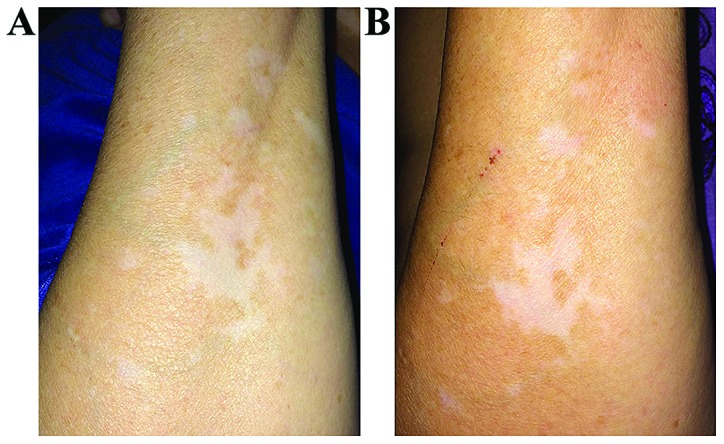
Pigmentation achieved after applying the PN extract ointment for 12 weeks. (A) initial moment; (B) final moment. PN, Piper nigrum.
Figure 6.

Pigmentation achieved after applying the pure piperine ointment for 12 weeks in the non-segmental vitiligo case. (A) initial moment; (B) final moment.
Discussion
Our study confirms the presence of piperine in PN and its capacity to stimulate pigmentation in the skin. The HPTLC results highlight the large variety of compounds that can be found in PN, which is an important fact considering they could all have therapeutic properties. Also, two Rf values can be observed in the chromatograms, suggesting the presence of two isomers in the pure piperine solution, both also present in our extract.
The antioxidant capacity is relevant to our study because of the implications of oxidative stress in the physiopathology of vitiligo. The RSC of the PN extract was approximately three times bigger than the one of pure piperine, due to the other bioactive compounds from the extract. The association of tyrosine seems to be beneficial, increasing the antioxidant activity by 10% (when associated with piperine: Q2) to 20% (when associated with the extract: Q4) (Table I). Unfortunately, we were not able to include the tyrosine in our ointments because of the pH incompatibility between tyrosine (pH 5.0) on the one hand, and our extract (pH 9.0) and piperine (pH 9.5) on the other hand.
The in vivo testing results were satisfactory, regarding both ointments. The ointment containing the PN extract led to the fastest results, the pigmentation being visible to the naked eye after only 3 weeks of application. This suggests the presence of other biologically active compounds playing an important role in the pigmentation process, a fact highlighted by the HPTLC results and consistent with the findings of previous studies (42).
As to the pigmentation pattern, a difference between the active compounds was noted: The PN extract led to pigmentation islands while the piperine alone led to a diffuse pigmentation.
The association of the travoprost solution was beneficial in both cases. Not only did it speed up the process but it also changed the pigmentation pattern, especially when associated with the extract. The travoprost solution alone caused a diffuse pigmentation at first, visible after only 3 weeks, changing the pattern to pigmentation islands after 9 weeks. When associated with the extract ointment, both patterns of pigmentation were observed.
Applying the ointments under an occlusive dressing did not bring as much benefit as we expected. It led to fast pigmentation in the first 3 weeks but did not keep up the pace for the rest of the testing period.
By analyzing the affected areas with a dermatoscope, we were able to see that the pigmentation islands appeared around the pigmented hairs (Fig. 4). This is consistent with the scientific literature affirming that re-pigmentation tends to occur mainly in those areas of skin where there are still pigmented hairs, since this suggests the presence of melanin reservoirs (49).
Figure 4.
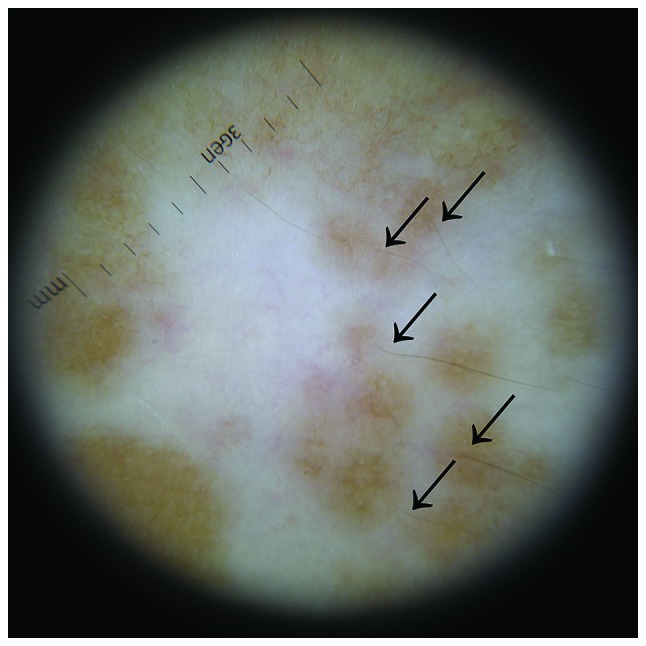
Dermatoscopic aspect of the pigmentation achieved after applying the PN extract ointment in association with the travoprost solution for 12 weeks. PN, Piper nigrum.
Regarding the subject with non-segmental vitiligo, the results were almost the opposite. The difference between the two ointments was not as noticeable and, moreover, the piperine alone led to slightly better results than the extract. Also, they both produced pigmentation islands, thus following the same pattern. However, this could be the consequence of the patches of affected skin being larger than the ones of the segmental vitiligo subject.
The side effects of our ointments were easily tolerated by our subjects. They described a slight burning sensation at the first applications, especially when applying the extract ointment under an occlusive dressing. Yet, one of the subjects withdrew from the study because of the intense burning sensation and the local redness and irritation. This might be caused by the sensitive and hyper-reactive skin type of the subject.
The present study has limitations due to the small number of patients and lesions and the absence of controls. In the future, larger batches of patients should be included. This was just the start point for further studies and observations on this novel, simple and cheap possible treatment for vitiligo; these first observations regarding the synthesis, pharmacologic content and clinical effects have to be reported. We believe that our study contains promising results that should be investigated further, especially taking into consideration the current context, in which identifying plant compounds that are active in diseases such as vitiligo is of great importance.
Although the results may not be permanent, PN and piperine could represent a less aggressive treatment alternative for vitiligo than the ones that are currently used. However, further studies are necessary to establish certain details such as how long does the pigmentation last, what happens once the application is interrupted or in what way could the skin type or color influence the results.
Figure 3.
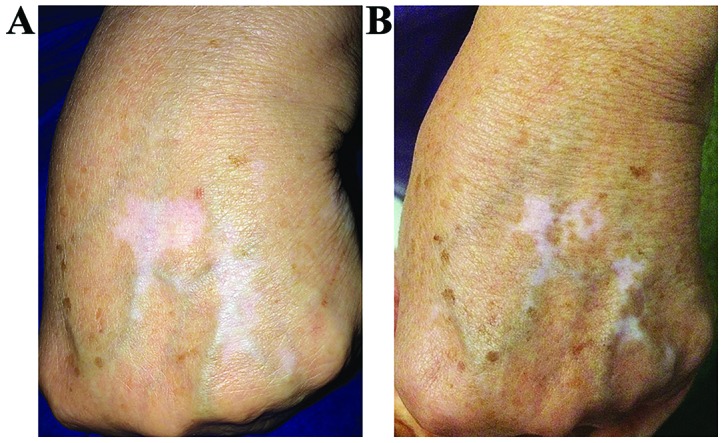
Pigmentation achieved after applying the PN extract ointment in association with the travoprost solution for 12 weeks. (A) initial moment; (B) final moment. PN, Piper nigrum.
Figure 5.
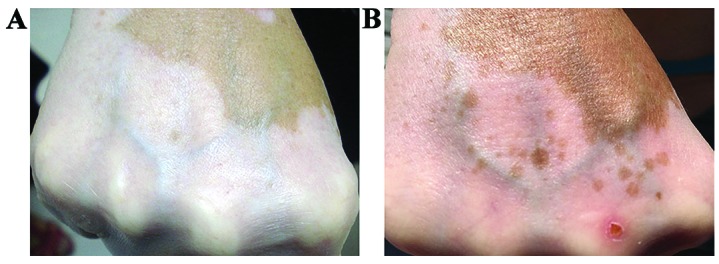
Pigmentation achieved after applying the PN extract ointment for 12 weeks in the non-segmental vitiligo case. (A) initial moment; (B) final moment. PN, Piper nigrum.
Acknowledgements
Not applicable.
Funding
No funding was received.
Availability of data and materials
All data generated or analyzed during this study are included in this published article.
Authors' contributions
RMD prepared and analyzed the extract. ODB performed the ointment formulation. BM was involved in all the stages of the study, prepared the ointments and was a major contributor in writing the manuscript. ALT examined the test subjects and evaluated the in vivo effects. All authors contributed to the conception and design of the study, as well as revising it. All authors read and approved the final manuscript to be published and agreed to be accountable for all aspects of the work in ensuring that questions related to the accuracy or integrity of any part of the work are appropriately investigated and resolved.
Ethics approval and consent to participate
The study was approved by the Local Ethics Commission of Comisia de Etica Universitara (CEU no. 3/30 of May 2018; Galați, Romania), and written informed consent for participation in the study was obtained from all patients.
Patient consent for publication
Written informed consent for the publication of the images was provided by all participants.
Competing interests
The authors declare that they have no competing interests.
References
- 1.Gawkrodger DJ, Ormerod AD, Shaw L, Mauri-Sole I, Whitton ME, Watts MJ, Anstey AV, Ingham J, Young K. Therapy Guidelines and Audit Subcommittee, British Association of Dermatologists; Clinical Standards Department, Royal College of Physicians of London; Cochrane Skin Group; Vitiligo Society: Guideline for the diagnosis and management of vitiligo. Br J Dermatol. 2008;159:1051–1076. doi: 10.1111/j.1365-2133.2008.08881.x. [DOI] [PubMed] [Google Scholar]
- 2.Speeckaert R, van Geel N. Vitiligo: An update on pathophysiology and treatment options. Am J Clin Dermatol. 2017;18:733–744. doi: 10.1007/s40257-017-0298-5. [DOI] [PubMed] [Google Scholar]
- 3.Nicolaidou E, Antoniou C, Stratigos A, Katsambas AD. Narrowband ultraviolet B phototherapy and 308-nm excimer laser in the treatment of vitiligo: A review. J Am Acad Dermatol. 2009;60:470–477. doi: 10.1016/j.jaad.2008.07.053. [DOI] [PubMed] [Google Scholar]
- 4.Whitton ME, Ashcroft DM, González U. Therapeutic interventions for vitiligo. J Am Acad Dermatol. 2008;59:713–717. doi: 10.1016/j.jaad.2008.06.023. [DOI] [PubMed] [Google Scholar]
- 5.Tatu AL, Ionescu MA. Multiple autoimmune syndrome type III-thyroiditis, vitiligo and alopecia areata. Acta Endo Buc. 2017;13:124–125. doi: 10.4183/aeb.2017.124. [DOI] [PMC free article] [PubMed] [Google Scholar]
- 6.Taïeb A, Picardo M. Clinical practice. Vitiligo. N Engl J Med. 2009;360:160–169. doi: 10.1056/NEJMcp0804388. [DOI] [PubMed] [Google Scholar]
- 7.Kim DY, Oh SH, Hann SK. Classification of segmental vitiligo on the face: Clues for prognosis. Br J Dermatol. 2011;164:1004–1009. doi: 10.1111/j.1365-2133.2010.10202.x. [DOI] [PubMed] [Google Scholar]
- 8.van Geel N, Bosma S, Boone B, Speeckaert R. Classification of segmental vitiligo on the trunk. Br J Dermatol. 2014;170:322–327. doi: 10.1111/bjd.12652. [DOI] [PubMed] [Google Scholar]
- 9.Mazereeuw-Hautier J, Bezio S, Mahe E, Bodemer C, Eschard C, Viseux V, Labreze C, Plantin P, Barbarot S, Vabres P, et al. Groupe de Recherche Clinique en Dermatologie Pédiatrique (GRCDP): Segmental and nonsegmental childhood vitiligo has distinct clinical characteristics: A prospective observational study. J Am Acad Dermatol. 2010;62:945–949. doi: 10.1016/j.jaad.2009.06.081. [DOI] [PubMed] [Google Scholar]
- 10.Ho N, Pope E, Weinstein M, Greenberg S, Webster C, Krafchik BR. A double-blind, randomized, placebo-controlled trial of topical tacrolimus 0·1% vs. clobetasol propionate 0·05% in childhood vitiligo. Br J Dermatol. 2011;165:626–632. doi: 10.1111/j.1365-2133.2011.10351.x. [DOI] [PubMed] [Google Scholar]
- 11.Anbar TS, Westerhof W, Abdel-Rahman AT, El-Khayyat MA. Evaluation of the effects of NB-UVB in both segmental and non-segmental vitiligo affecting different body sites. Photodermatol Photoimmunol Photomed. 2006;22:157–163. doi: 10.1111/j.1600-0781.2006.00222.x. [DOI] [PubMed] [Google Scholar]
- 12.Cavalié M, Ezzedine K, Fontas E, Montaudié H, Castela E, Bahadoran P, Taïeb A, Lacour JP, Passeron T. Maintenance therapy of adult vitiligo with 0.1% tacrolimus ointment: A randomized, double blind, placebo-controlled study. J Invest Dermatol. 2015;135:970–974. doi: 10.1038/jid.2014.527. [DOI] [PubMed] [Google Scholar]
- 13.Garza-Mayers AC, Kroshinsky D. Low-dose methotrexate for vitiligo. J Drugs Dermatol. 2017;16:705–706. [PubMed] [Google Scholar]
- 14.Radakovic-Fijan S, Fürnsinn-Friedl AM, Hönigsmann H, Tanew A. Oral dexamethasone pulse treatment for vitiligo. J Am Acad Dermatol. 2001;44:814–817. doi: 10.1067/mjd.2001.113475. [DOI] [PubMed] [Google Scholar]
- 15.Tatu AL, Ionescu MA, Clatici VG, Cristea VC. Bacillus cereus strain isolated from Demodex folliculorum in patients with topical steroid-induced rosaceiform facial dermatitis. An Bras Dermatol. 2016;91:676–678. doi: 10.1590/abd1806-4841.20165214. [DOI] [PMC free article] [PubMed] [Google Scholar]
- 16.Tatu AL. Topical steroid induced facial rosaceiform dermatitis. Acta Endo Buc. 2016;12:232–233. doi: 10.4183/aeb.2016.232. [DOI] [PMC free article] [PubMed] [Google Scholar]
- 17.Kubiak K, Sielawa H, Chen W, Dzika E. Endosymbiosis and its significance in dermatology. J Eur Acad Dermatol Venereol. 2018;32:347–354. doi: 10.1111/jdv.14721. [DOI] [PubMed] [Google Scholar]
- 18.Tatu AL, Ionescu MA, Nwabudike LC. Contact allergy to topical mometasone furoate confirmed by rechallenge and patch test. Am J Ther. 2018;25:e497–e498. doi: 10.1097/MJT.0000000000000581. [DOI] [PubMed] [Google Scholar]
- 19.Tatu AL, Clatici V, Cristea VC. Isolation of Bacillus simplex strain from Demodex folliculorum and observations about Demodicosis spinulosa. Clin Exp Dermatol. 2016;41:818–820. doi: 10.1111/ced.12893. [DOI] [PubMed] [Google Scholar]
- 20.Tatu AL, Ionescu MA, Cristea VC. Demodex folliculorum associated Bacillus pumilus in lesional areas in rosacea. Indian J Dermatol Venereol Leprol. 2017;83:610–611. doi: 10.4103/ijdvl.IJDVL_921_16. [DOI] [PubMed] [Google Scholar]
- 21.Gambichler T, Rüddel I, Hessam S, Bechara FG, Stockfleth E, Schmitz L. Altered epigenetic pathways and cell cycle dysregulation in healthy appearing skin of patients with koebnerized squamous cell carcinomas following skin surgery. J Eur Acad Dermatol Venereol. 2018 Feb 25; doi: 10.1111/jdv.14887. (Epub ahead of print). doi: 10.1111/jdv.14887. [DOI] [PubMed] [Google Scholar]
- 22.Tatu AL, Nwabudike LC. Rosacea-like demodicosis (but not primary demodicosis) and papulo pustular rosacea may be two phenotypes of the same disease - a microbioma, therapeutic and diagnostic tools perspective. J Eur Acad Dermatol Venereol. 2018 Jun 29; doi: 10.1111/jdv.15166. (Epub ahead of print). doi: 10.1111/jdv.15166. [DOI] [PubMed] [Google Scholar]
- 23.Tatu AL. Nasal spinulosis. J Cutan Med Surg. 2017;21:339. doi: 10.1177/1203475417694861. [DOI] [PubMed] [Google Scholar]
- 24.Tatu AL, Cristea VC. Pityriasis folliculorum of the back thoracic area: Pityrosporum, keratin plugs, or demodex involved? J Cutan Med Surg. 2017;21:441. doi: 10.1177/1203475417711114. [DOI] [PubMed] [Google Scholar]
- 25.Tatu AL, Cristea VC. Unilateral blepharitis with fine follicular scaling. J Cutan Med Surg. 2017;21:442. doi: 10.1177/1203475417711124. [DOI] [PubMed] [Google Scholar]
- 26.Tatu AL, Nwabudike LC, Reply to Happle R. et al. Koebners sheep in Wolfs clothing: does the isotopic response exists as a distinct phenomenon? J Eur Acad Dermatol Venereol. 2018 Feb 28; doi: 10.1111/jdv.14900. (Epub ahead of print). doi: 10.1111/jdv.14900. [DOI] [PubMed] [Google Scholar]
- 27.Negrei C, Căruntu C, Ginghină O, Burcea-Dragomiroiu GT, Toderescu CD, Boda D. Qualitative and quantitative determination of methotrexate polyglutamates in erythrocytes by high performance liquid chromatography. Rev Chim. 2015;66:607–610. [Google Scholar]
- 28.Negrei C, Ginghină O, Căruntu C, Burcea-Dragomiroiu GT, Jinescu G, Boda D. Investigation relevance of methotrexate polyglutamates in biological systems by high performance liquid chromatography. Rev Chim. 2015;66:766–768. [Google Scholar]
- 29.Batani A, Brănișteanu DE, Ilie MA, Boda D, Ianosi S, Ianosi G, Caruntu C. Assessment of dermal papillary and microvascular parameters in psoriasis vulgaris using in vivo reflectance confocal microscopy. Exp Ther Med. 2018;15:1241–1246. doi: 10.3892/etm.2017.5542. [DOI] [PMC free article] [PubMed] [Google Scholar]
- 30.Ion R, Boda D. Porphyrin-based supramolecular nanotubes generated by aggregation processes. Rev Chim. 2008;59:205–207. [Google Scholar]
- 31.Boda D, Ion RM. Synthesis, spectral and photodynamic properties of lithium phthalocyanine. Rev De Chim. 2014;65:1271–1274. [Google Scholar]
- 32.Wolff K, Goldsmith LA, Katz SI, Gilchrest BA, Paller AS, Leffell DJ. 7th. McGraw Hill Medical; USA: 2008. Fitzpatricks Dermatology in General Medicine; pp. 616–621. [Google Scholar]
- 33.Ortonne JP. Vitiligo and other disorders of hypopigmentation. In: Bolognia JL, Jorizzo JL, Rapini RP, editors. Dermatology. 2nd. Mosby Elsevier; Simi Valley, CA, USA: 2008. pp. 913–920. [Google Scholar]
- 34.Tatu AL, Nwabudike LC. Metoprolol-associated onset of psoriatic arthropathy. Am J Ther. 2017;24:e370–e371. doi: 10.1097/MJT.0000000000000560. [DOI] [PubMed] [Google Scholar]
- 35.Tatu AL, Nwabudike LC. Bullous reactions associated with COX-2 inhibitors. Am J Ther. 2017;24:e477–e480. doi: 10.1097/MJT.0000000000000569. [DOI] [PubMed] [Google Scholar]
- 36.Buzia OD, Fasie V, Mardare N, Diaconu C, Gurau G, Tatu AL. Formulation, preparation, physico-chimical analysis, microbiological peculiarities and therapeutic challenges of extractive solution of Kombucha. Rev Chim Buchar. 2018;69:720–724. [Google Scholar]
- 37.Zălaru C, Crişan C, Călinescu I, Moldovan Z, Ţârcomnicu I, Litescu S, Tatia R, Moldovan L, Boda D, Iovu M. Polyphenols in Coreopsis tinctoria Nutt. fruits and the plant extracts antioxidant capacity evaluation. Open Chem. 2014;12:858–867. [Google Scholar]
- 38.Ionescu C, Țârcomnicu I, Ionescu MA, Nicolescu TO, Boda D, Nicolescu F. Identification and characterization of the methanolic extract of hellebrigenin 3-acetate from hellebori rhizomes. Mass spectrometry. Rev Chim. 2014;1:972–975. [Google Scholar]
- 39.Raţiu MP, Purcărea I, Popa F, Purcărea VL, Purcărea TV, Lupuleasa D, Boda D. Escaping the economic turn down through performing employees, creative leaders and growth driver capabilities in the Romanian pharmaceutical industry. Farmacia. 2011;59:119–130. [Google Scholar]
- 40.Meghwal M, Goswami TK. Chemical composition, nutritional, medicinal and functional properties of black pepper: A review. Open Access Sci Rep. 2012;1:172. [Google Scholar]
- 41.Faas L, Venkatasamy R, Hider RC, Young AR, Soumyanath A. In vivo evaluation of piperine and synthetic analogues as potential treatments for vitiligo using a sparsely pigmented mouse model. Br J Dermatol. 2008;158:941–950. doi: 10.1111/j.1365-2133.2008.08464.x. [DOI] [PubMed] [Google Scholar]
- 42.Lin Z, Liao Y, Venkatasamy R, Hider RC, Soumyanath A. Amides from Piper nigrum L. with dissimilar effects on melanocyte proliferation in-vitro. J Pharm Pharmacol. 2007;59:529–536. doi: 10.1211/jpp.59.4.0007. [DOI] [PubMed] [Google Scholar]
- 43.Hamrapurkar PD, Jadhav Kavita, Sandip Zine. Quantitative estimation of piperine in Piper nigrum Piper longum using high performance thin layer chromatography. J Appl Pharm Sci. 2011;1:117–120. [Google Scholar]
- 44.Bozin B, Mimica-Dukic N, Samojlik I, Goran A, Igic R. Phenolics as antioxidants in garlic (Allium sativum L., Alliaceae) Food Chem. 2008;111:925–929. doi: 10.1016/j.foodchem.2008.04.071. [DOI] [Google Scholar]
- 45.Choi YM, Diehl J, Levins PC. Promising alternative clinical uses of prostaglandin F2α analogs: Beyond the eyelashes. J Am Acad Dermatol. 2015;72:712–716. doi: 10.1016/j.jaad.2014.10.012. [DOI] [PubMed] [Google Scholar]
- 46.Kapur R, Osmanovic S, Toyran S, Edward DP. Bimatoprost-induced periocular skin hyperpigmentation: Histopathological study. Arch Ophthalmol. 2005;123:1541–1546. doi: 10.1001/archopht.123.11.1541. [DOI] [PubMed] [Google Scholar]
- 47.Feletti F, Vincenzi C, Pazzaglia M, Tosti A. Periocular pigmentation associated with use of travoprost for the treatment of alopecia areata of the eyelashes. J Eur Acad Dermatol Venereol. 2007;21:421–423. doi: 10.1111/j.1468-3083.2006.01911.x. [DOI] [PubMed] [Google Scholar]
- 48.Anbar TS, El-Ammawi TS, Abdel-Rahman AT, Hanna MR. The effect of latanoprost on vitiligo: a preliminary comparative study. Int J Dermatol. 2015;54:587–593. doi: 10.1111/ijd.12631. [DOI] [PubMed] [Google Scholar]
- 49.Menon SM, Sharma YK, Bansal P, Ghadgepatil SS. Restoration of pigmentation by follicular unit extraction transplant in three cases of focal vitiligo recalcitrant to therapy including with previous nonculture melanocyte-keratinocyte transplant. Int J Trichology. 2016;8:87–88. doi: 10.4103/0974-7753.188041. [DOI] [PMC free article] [PubMed] [Google Scholar]
Associated Data
This section collects any data citations, data availability statements, or supplementary materials included in this article.
Data Availability Statement
All data generated or analyzed during this study are included in this published article.



